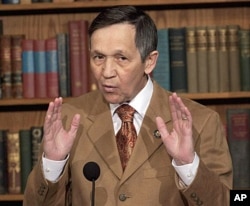As hot-button campaign issues go, international free trade agreements aren’t exactly sexy. During most U.S. election campaigns, trade is a relatively minor concern.
But in 2016, as the two party nominees emerge from their conventions to face off in the general election campaign, free trade has emerged as one of the most important issues. It is especially crucial in a tier of northern states in the middle of the country that many say could decide the next president.
The debate has focused on the Trans-Pacific Partnership, or TPP, a sweeping, 12-nation trade deal that would encompass 40 percent of the world’s economy.
Supporters say the TPP would loosen trade barriers and spur global economic growth. Opponents argue it would mainly support big businesses, and send jobs overseas to low-wage countries.
Democratic presidential nominee Hillary Clinton and her Republican rival Donald Trump both oppose the TPP. The Democratic runner-up Bernie Sanders was also an outspoken opponent.
Rallying cry
At this week’s Democratic convention in Philadelphia, Sanders supporters have cited the trade deal as an example of how government policies have ignored the U.S. worker.
They have used the issue as a rallying cry, wearing buttons, holding signs and repeatedly interrupting speeches with chants against the free trade deal.
“It’s an absolute disaster,” says Guy Anthony, a retired machinist and union organizer. “It’s bad for working people.”
Anthony is a delegate from Pennsylvania, which lies on the eastern edge of the so-called Rust Belt states where manufacturing plays a key role in the economy.
Key battleground
The states that have lost a large number of jobs overseas as manufacturing declined in recent decades are set to play a key role in the November general election.
For the last 20 years, the Rust Belt has leaned toward the Democratic Party. Last election, five states in the region – Pennsylvania, Ohio, Michigan, Wisconsin and Iowa – all voted for President Barack Obama, a Democrat.
But this year, in part because of his fierce opposition to the TPP and other free trade agreements, the region has been unexpectedly receptive to Trump.
Polls show that Trump is competitive with Clinton throughout the Rust Belt, and in some cases is even ahead. If Trump takes all or some of the states, many analysts have said it could be enough for him to win the election.
One of the most strategic states in the region is Ohio. Dennis Kucinich, a former Democratic congressman and presidential candidate, told VOA free trade deals are among the reasons why his state is up for grabs. He said workers have been “sold out by both political parties.”
“Trade agreements … have cost this country millions of jobs, lowered the standard of living, knocked down wages, cut benefits and reduced pensions,” said Kucinich, a liberal with a long record of opposing free trade agreements.
Clinton stance
Another reason why the region is leaning more toward Trump may be Clinton’s record on trade.
Her husband, former President Bill Clinton, signed the North American Free Trade Agreement, or NAFTA, in 1993. Some have blamed it for a loss of jobs.
Some also worry Hillary Clinton will reverse her position and eventually back the TPP, since she was one of the deal’s main architects during her time as secretary of state.
“I’m pretty confident she’ll flip her position back on it” if she becomes president,” says Susan Hall, a Sanders delegate from Pennsylvania.
Clinton’s team has denied that accusation, saying the TPP does not meet her standards for protecting U.S. workers.
But that hasn’t stopped Trump from claiming Clinton is only temporarily opposed to the deal.
“We all know it is going to happen if she won,” Trump said during a press conference Wednesday.
TP-what?
But for all the attention the TPP is getting on the campaign trail, there is evidence to suggest that many Americans don’t even know what it is.
“I’ll bet if we asked a sample of people what the TPP is, a lot would say, ‘Toilet paper something,’” says Charley Ballard, who teaches economics and conducts opinion surveys at Michigan State University.
Before the election, the TPP was not at all well known to Americans, Ballard says. “I think it probably still isn’t well-known,” even with all the attention during the campaign, he adds.
A poll earlier this year suggested that 72 percent of Americans either hadn’t heard of the TPP or had heard “not much about it.”
Gary Hawley, a Wisconsin delegate and retired union carpenter, concedes many in his state may not even see the TPP as a key issue.
“I don’t think people know enough about the TPP, and you’ve got to know about something before you can agree or disagree with it,” he says.
Another Rust Belt delegate, Tom Richey of Ohio, says he is ambivalent on the trade deal, saying other issues are a bigger concern.
“I think folks ought to focus instead on all the jobs Donald Trump has sent out of the country with his businesses,” he says.










